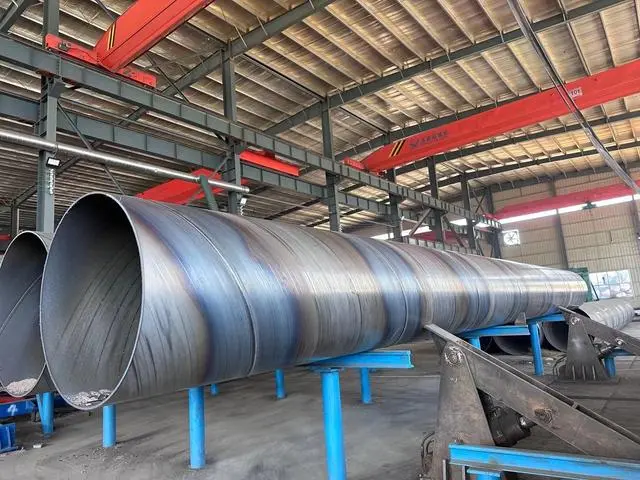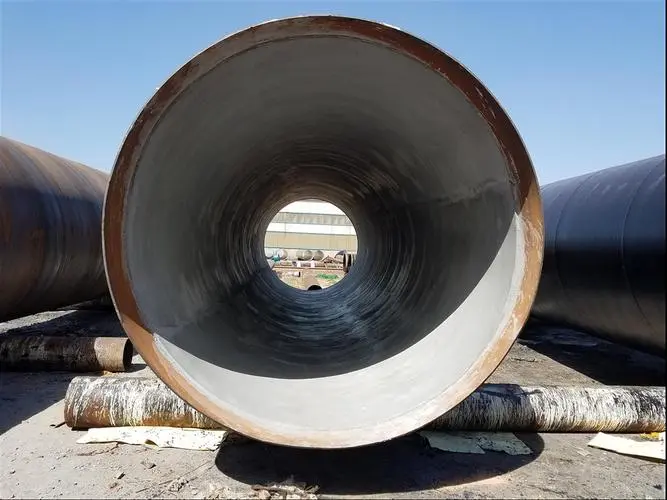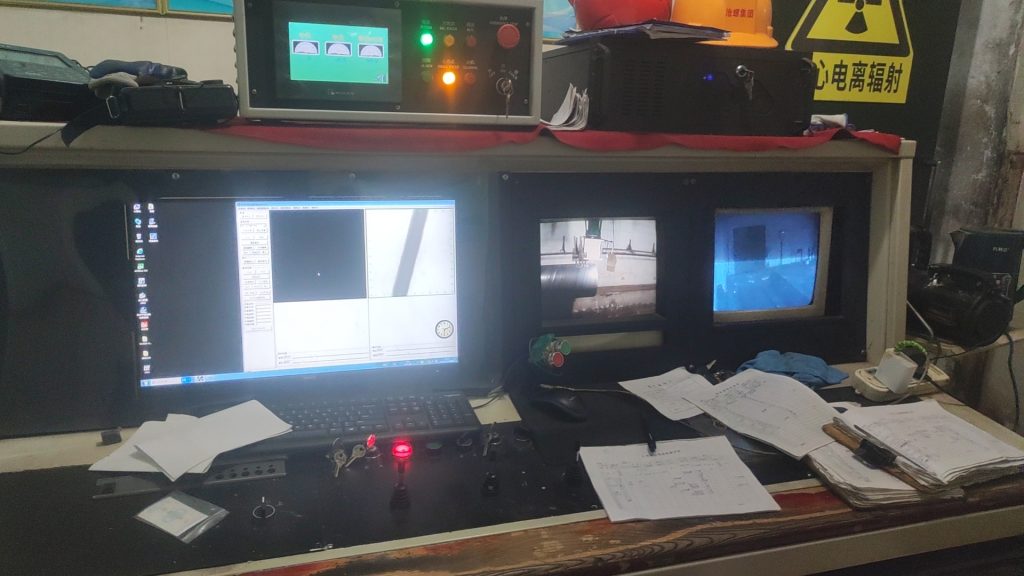Spiral welded steel pipe is a spiral seam steel pipe welded by automatic double-wire double-sided submerged arc welding process using strip steel coil plate as raw material, constant temperature extrusion molding. Spiral welded steel pipe, also called spiral pipe, ssaw pipe, spiral steel pipe, spiral double-sided submerged arc welded steel pipe, is a type of carbon steel pipe. This article introduces spiral welded steel pipes by manufacturers on the classification, parameters, production process, welding seam treatment, process characteristics, quality testing, performance characteristics, application fields, and spiral welded steel pipes.

Spiral welded steel pipes are generally produced with a diameter of 8-140 inches and a wall thickness of 6-26mm. When the diameter is greater than 23 inches, it is called large-diameter spiral welding. Large-diameter spiral welded steel pipes are divided into thin-walled large-diameter spiral steel pipes and thick-walled large-diameter spiral welded steel pipes.
(1) Steel pipes with different diameters can be produced using hot-rolled strips of the same width, especially narrow strips of steel can be used to produce large-diameter steel pipes.
(2) Under the same working pressure standard, it can bear great working pressure. Compared with straight seam steel pipes of the same diameter, the wall thickness can be reduced by 10% to 25% under the same pressure.
(3) The specifications are accurate. Generally, the diameter size tolerance does not exceed 0.12%, the deflection value is less than 2000, and the ovality is less than 1%. Generally, the die and alignment process can be eliminated.
(4) Sustainable production can theoretically produce very long steel pipes with little damage from head and tail cutting, which can increase the metal utilization rate by 6% to 8%.
(5) Compared with straight seam steel pipes, it is easy to operate and easy to change types and adjust.
(6) The machinery and equipment are light in weight and the initial project investment is small. It can be made into a trolley-type mobile generator, and welded steel pipes can be produced directly at the construction site where pipelines are laid.
(7) Facilitate the completion of mechanical automation and automation technology.

1.Chinese standards: GB/T 9711.2-1997, GB/T 9711.3-2005, etc.
2.American standards: API SPEC 5L, ASTM A252, etc.
3.European standards: EN10217, EN10219, etc.

Spiral steel pipes are usually made from a variety of materials, common materials include:
1.Carbon steel: such as Q235, Q345, etc., suitable for general-purpose pipes and structures.
2.Low alloy steel: such as 16Mn, Q345B, etc., has high strength and corrosion resistance, and is suitable for special projects and occasions with higher requirements.
3.High alloy steel: such as X42, X52, X65, etc., which have good high temperature resistance and pressure resistance and are often used in pipelines for special purposes such as oil and natural gas.
4.High-strength steel: such as X70, X80, etc., which have higher strength and pressure resistance, and are often used in special projects and occasions requiring high strength.
These materials are based on different engineering needs and environmental requirements. Choosing the right materials can ensure the performance and durability of spiral steel pipes.
Spiral welded steel pipes are produced in diameters from 8 to 140 inches.
The production wall thickness of spiral welded steel pipe is 6-26mm.
The production length of spiral welded steel pipe is 3-12 meters and customized.
The lining of spiral welded steel pipes first involves the choice of coating. The selection of lining should be comprehensively considered based on the environment where the steel pipe is located, the medium being transported, temperature, pressure and other factors. Common linings include epoxy resin, polyurethane, polyethylene, etc., which have good chemical resistance, friction resistance and temperature resistance.
Material is the key to choosing a suitable coating for spiral welded steel pipes. Commonly used coating materials include zinc-rich paint, epoxy resin, polyhydrogen ester, polyacrylate, etc. These materials should have excellent weather resistance, corrosion resistance, abrasion resistance and UV resistance.
The anti-corrosion layer of steel pipes is crucial to the life of buried pipelines. Some pipes of the same material will not corrode after being buried underground for decades, while others will leak within a few years. It’s because they use different anti-corrosion layers.

Large-diameter thin-walled spiral steel pipes are preheated before welding and cooled slowly after welding, so that the austenite decomposition in the heat-affected zone can proceed within a sufficient temperature range, avoiding the generation of hardened structures, and at the same time reducing welding stress; after welding Carry out low-temperature annealing in a timely manner to remove the stress generated during welding and allow hydrogen to diffuse to the outside world in a timely manner.
After the two edges of the broken pipe are heated to the welding temperature, they are squeezed by the squeeze roller to form common metal grains that penetrate and crystallize with each other, eventually forming a strong weld. If the extrusion force is too small, the number of common crystals formed will be small, the strength of the weld metal will decrease, and cracking will occur after stress; if the extrusion force is too large, the molten metal will be squeezed out of the weld, which will not only reduce the The strength of the weld is reduced, and a large number of internal and external burrs will be produced, even causing defects such as welding laps.
The processed steel pipe has greater flexibility in the diameter and wall thickness of the steel pipe size range, especially in the production of high-grade thick-walled steel pipes, especially large-diameter thick-walled pipes. It has advantages that other processes cannot match, and can meet the needs of Users have more requirements in terms of steel pipe specifications.
The process of pre-welding first and then internal and external welding (precision welding) can be used to achieve welding at the best position. Defects such as misalignment, welding deflection and incomplete penetration are less likely to occur, and the welding quality is easy to control. The overall mechanical diameter expansion can effectively improve the dimensional accuracy of the steel pipe and improve the distribution of stress within the steel pipe, thereby avoiding damage caused by stress corrosion and conducive to on-site splicing construction.
The spiral steel pipe feeds the strip into the welded pipe unit. After being rolled by multiple rollers, the strip is gradually rolled up to form a circular tube blank with an opening gap. Adjust the reduction amount of the extrusion roller to control the weld gap between 1~ 3mm, and make both ends of the welding joint flush.
If the gap is too large, the proximity effect will be reduced, the eddy current heat will be insufficient, and the joint between the welding products will be poor, resulting in lack of fusion or cracking.
If the gap is too small, the proximity effect will increase and the welding heat will be too high, causing the weld to burn out; or the weld will form a deep pit after being extruded and rolled, affecting the surface quality of the weld.
After the two edges of the tube blank are heated to the welding temperature, they are squeezed by the extrusion roller to form a common metal grain that penetrates and bonds with each other, ultimately forming a strong weld. If the extrusion force of the spiral steel pipe is too small, the number of common bodies formed will be small, the strength of the weld metal will decrease, and cracking will occur after stress; if the extrusion force is too large, the molten metal will be extruded out of the weld. , not only reduces the strength of the weld, but also produces a large number of internal and external burrs, and even causes defects such as welding laps.

a. During the forming process, the steel plate deforms evenly, has small residual stress, and does not produce scratches on the surface. The processed spiral steel pipe has greater flexibility in the size range of diameter and wall thickness, especially in the production of high-grade thick-walled pipes, especially small and medium-diameter thick-walled pipes. It has advantages that other processes cannot match, and can satisfy users More requirements in terms of spiral steel pipe specifications.
b. Using the advanced double-sided submerged arc welding process, welding can be achieved at the best position, and defects such as wrong edges, welding deviations, and incomplete welding are less likely to occur, and the welding quality can be easily controlled.
c. Conduct 100% quality inspection of steel pipes so that the entire process of steel pipe production is under effective detection and monitoring, effectively ensuring product quality.
d. All equipment in the entire production line has the function of networking with the computer data collection system to realize real-time transmission of data, and the central control room monitors the technical parameters in the production process.
The spiral welded pipe utilizes electric pressure gauges to control cylinder pressure for smooth strip transportation. Roller forming, either externally or internally controlled, is employed. A weld gap control device ensures compliance with welding requirements, strictly managing pipe diameter, offset, and weld gap. Internal and external welding is executed using American Lincoln electric welders with single or double wire welding machines, ensuring stable welding. Completed welds undergo online continuous ultrasonic automatic flaw detection for 100% non-destructive testing coverage, triggering automatic alarms and marking defects for timely adjustment of process parameters. Steel pipe is cut into individual pieces using an air plasma cutting machine.
After the spiral pipe factory is cut into individual steel pipes, each batch of steel pipes must undergo a strict first inspection system to check the mechanical properties, chemical composition, fusion status of the welds, the surface quality of the steel pipes, and non-destructive testing to ensure that the pipe making process is qualified. Only then can it be officially put into production. The parts with continuous sonic flaw detection marks on the welds will be reviewed by manual ultrasonic and X-ray. If there are defects, they will be repaired and then go through non-destructive inspection again until it is confirmed that the defects have been eliminated.
Raw material inspection–leveling inspection–butt welding inspection–forming inspection–internal welding inspection–external welding inspection–pipe cutting inspection–super Jibo inspection–bevel inspection–outline dimensional inspection–X-ray Inspection – Hydraulic Test – Final Inspection In order to ensure product quality, we have formulated a complete quality plan, on-site work procedures and inspection and test plans.
1.High-strength spiral steel pipe has high yield strength and tensile strength, can withstand large pressure, and ensures the safety of fluid transportation.
2.Good plasticity: Spiral steel pipe has good elongation and impact toughness, and can absorb energy when impacted by external forces, reducing the risk of damage.
3.Excellent corrosion resistance: Spiral steel pipes have undergone anti-corrosion treatment and can effectively resist corrosive media in soil, water and other environments, extending their service life.
4.Good sealing: The welds of spiral steel pipes adopt advanced welding technology to ensure the quality of the welds and reduce the risk of leakage.
5.Easy to install and maintain: Spiral steel pipe has a simple structure, is easy to install, and has low maintenance costs, making it suitable for various complex environments.
(1) High requirements on production technology: The production technology of spiral steel pipe is relatively complex, requiring high-precision equipment and skilled operators, and has high requirements on production technology.
(2) Welding quality affects the service life: The welding quality of the spiral steel pipe directly affects its service life and safety, so the quality needs to be strictly controlled during the welding process.
(3) High requirements for the transmission medium: When transporting certain special media, such as high temperature, high pressure, strong corrosion, etc., spiral steel pipes need to use special materials and anti-corrosion measures, otherwise they will be easily damaged.
application
The solid structure and excellent performance of spiral welded steel pipes play an important role in various fields, providing reliable support for infrastructure construction, energy transmission and environmental protection projects.
1.Construction field
Spiral steel pipes are widely used in the construction field, such as supports and guardrails of bridges, tunnels, subways, overpasses and other buildings. These buildings require a large number of steel pipes as supports, and spiral steel pipes are widely used because of their high stiffness, strong compression resistance, and ability to withstand large weights and pressures.
2.Petrochemical field
Spiral steel pipes are also widely used in the petrochemical industry, such as oil pipelines, natural gas pipelines, and oil and natural gas transmission pipelines. These pipelines require steel pipes with strong corrosion resistance, high temperature resistance, and pressure resistance, so spiral steel pipes have become an ideal choice.
3.Coal mines and mining fields
In the field of coal mines and mining, spiral steel pipes are widely used in underground drainage and ventilation systems. These systems require steel pipes with good anti-corrosion and corrosion resistance, and spiral steel pipes can just meet these needs.
4.Water conservancy engineering field
Spiral steel pipes are also widely used in the field of water conservancy projects, such as spillways, drainage pipes, and water supply pipes of large reservoirs. These pipes need to have good pressure resistance and corrosion resistance, and spiral steel pipes can meet these needs.
1.For liquid transportation: crude oil, petroleum, water supply, drainage, sewage.
2.For gas transportation: coal gas, steam, liquefied petroleum gas, natural gas.
3.For structural use: used as piling pipes, bridges; pipes for docks, roads, building structures, etc.
Cangzhou DoubleDragon Steel Pipe Co., Ltd specializes in the production of spiral welded steel pipes, including coating and lining spiral welded steel pipes. The factory has been established for 30 years, with production diameters of 8-140 inches and wall thicknesses of 6-26mm . Friends from all over the world are welcome to exchange and consult.

1.Quality control, dimensional standards: Raw materials undergo strict physical and chemical inspections, and a complete finished product inspection process ensures product qualification rate and ensures that various parameters and sizes meet standards.
2.Non-standard customization: Spiral welded pipe products with non-standard outer diameter, non-standard length and non-standard thickness can be customized to meet various personalized needs of customers.
3.High-quality processing: The company currently has 11 submerged arc welding spiral welded pipe production lines, and has 2 full anti-corrosion production lines (anti-corrosion, plastic coating). It can perform anti-corrosion processing on steel pipes according to customer engineering needs.
4.Sufficient inventory: Sufficient inventory, immediate delivery. The product production efficiency is high, the inventory product models are complete, and the storage area is large.
1.Professional manufacturer: The factory has been established for 30 years, has rich production experience, and supplies products all over the world.
2.Delivery capacity: annual output of 400,000 tons of spiral steel pipes, one-stop service from production to delivery, and timely delivery.
3.Quality assurance: strictly implement production standards according to customer requirements.
4.After-sales service: service staff with 15 years of experience, 24-hour product consultation, and product warranty.
You must be logged in to post a comment.

